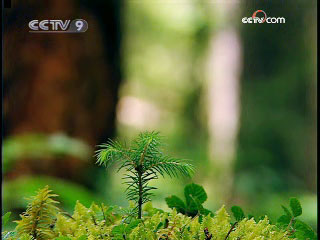------Program code: NS-080811-01856 (what's this?)
Source: CCTV.com
08-11-2008 09:26
China is the home of bamboo. 85% of bamboo in the world is found in the region south of the Yangtze River. It is a generous plant, because the bamboo forest will not filter out all the sunlight. The light and heat that reach the ground make it possible for shrubs to grow in the forest. For botanists, this is a kingdom of insects, a haven for birds, and a focal point of amphibian and reptile research. The bamboo forest is also home to the greatest abundance of butterfly species.
 |
Southern China, where the sunlight is plentiful, is a fascinating place to observe the battle for survival. The tropical rainforest below Jianfengling in Hainan Province is extremely crowded. On one hectare of land, 150,000 young plants take root and sprout every year. But fewer than one in a hundred of them will grow into a tall tree. Every single tree and seed is surrounded by enemies.
The greengage seeds begin their journey of life in a stream, flowing with the current. If they can’t find a suitable place to sprout in 10 days, they will die. Near the bank, a log, destroyed last year by the typhoon, is lying. The log’s surface is first occupied by funguses, which grow and rot quickly. Then it is covered by lichen.
 |
There are sufficient nutritional elements in the tropical rainforest. But for the seeds and seedlings, what’s more important is that this fallen tree provides them with a small, but nonetheless vital, skylight, through which the sunlight pours onto the ground.
Beside the log, a greengage seedling is already growing.
In the rainforest, the plants are distributed according to their height. On the wet ground, during the wet season, the fungi grow fast.
Just above the fungi, the leaves of the palmaceous plants grow thickly.
Beneath the tree tops, the vines climb and twist, as they grow among the plants. There are numerous types of epiphytic plant, and they grow in abundance. With all these layers to block it, little sunlight reaches the ground.
If it is fortunate, decades from now, the greengage seedling will have grown into a tall tree, monopolizing its skylight.
On China’s territory, the only sizeable areas of tropical rainforest are found on Hainan Island, in Xishuangbanna in Yunnan, and in southeastern Tibet. The rainforest surrounding Jianfengling in Hainan is home to 15% of the plant species found in China. As such, it is known as a gene bank of northern tropical flora and fauna.
The battle for survival among the plants is silent, but the insects are much nosier. The red tree ants live on the branches of the Hainan madhuca tree. These are also their hunting grounds. The Hainan madhuca trees provide shelter for the red tree ants and, in return, the ants protect the trees from leaf-eating insects.
Even something as fierce as a wasp, if it invades the red tree ants’ territory, will come under attack.
Although the red tree ants are vulnerable, the wasp has no chance. More and more ants come to help.
Editor:Yang
